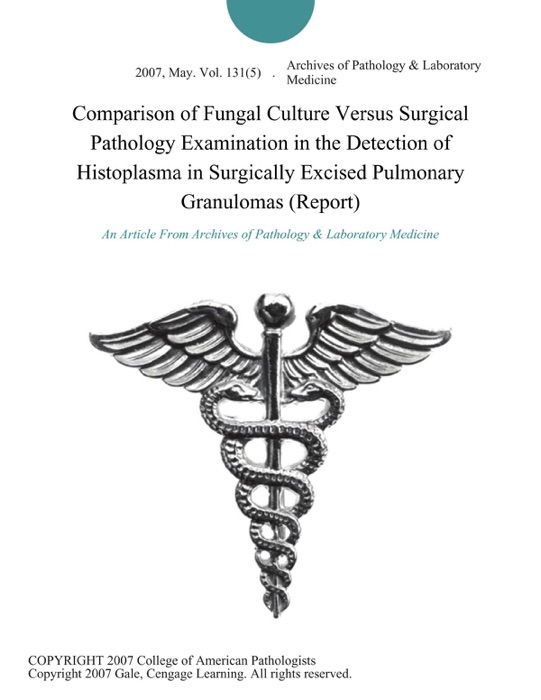[Download] ~ Comparison of Fungal Culture Versus Surgical Pathology Examination in the Detection of Histoplasma in Surgically Excised Pulmonary Granulomas (Report) by Archives of Pathology & Laboratory Medicine ~ eBook PDF Kindle ePub Free

eBook details
- Title: Comparison of Fungal Culture Versus Surgical Pathology Examination in the Detection of Histoplasma in Surgically Excised Pulmonary Granulomas (Report)
- Author : Archives of Pathology & Laboratory Medicine
- Release Date : January 01, 2007
- Genre: Health & Fitness,Books,Health, Mind & Body,
- Pages : * pages
- Size : 236 KB
Description
Histoplasma capsulatum is a thermally dimorphic fungus that is found in a wide geographic distribution, but in the United States most commonly infects those living in the Mississippi and Ohio river valleys. H capsulatum (henceforth referred to simply as Histoplasma) is found in the environment, particularly soil enriched with bat and bird droppings, and exposure to the organism is usually via inhalation of microconidia or hyphal fragments. (1-3) It is estimated that 50% to 80% of people living in endemic areas are exposed to this organism based on serologic data. (4,5) Pulmonary Histoplasma infection can be broadly categorized by clinical presentation and tempo of disease. Acute pulmonary histoplasmosis occurs in those who are acutely exposed to a large burden of organism. This form of Histoplasma infection is typically asymptomatic and most often resolves spontaneously in the immunocompetent host. The minority of patients who do exhibit pulmonary symptoms may require antifungal treatment if disease is persistent and severe. The chronic (cavitary) pulmonary form of histoplasmosis is strongly associated with underlying chronic obstructive pulmonary disease, may be self-limited in some patients, and generally requires antifungal treatment. (1) In either the acute or chronic forms, a parenchymal granulomatous nodule may present as a radiographically suspicious pulmonary lesion. Histoplasma granulomatous nodules (histoplasmomas or fibrocaseous nodules) are not always calcified, and they may demonstrate significant metabolic activity on functional imaging, such as with positron emission tomography (PET) studies. (6) In cases where a percutaneous or bronchoscopic biopsy is not possible, these lesions may require the intervention of a thoracic surgeon in order to exclude neoplasia. In our practice, wedge resection of a suspicious pulmonary nodule/lesion is generally performed first, followed by intraoperative frozen section analysis in the surgical pathology laboratory. If the frozen section diagnosis yields granulomatous nodule, no further surgical treatment is required, and tissue is routinely sent to the microbiology laboratory for direct smears, fungal cultures, and mycobacterial cultures in order to exclude or document an infectious etiology. Although microbiologic culture is traditionally accepted as the gold standard for the diagnosis of infectious disease, it has been previously noted that fungal cultures of pulmonary granulomatous nodules are often of low yield. (7,8) We anecdotally noted that histochemical staining of formalin-fixed, paraffin-embedded material often yields a morphologic diagnosis of Histoplasma in spite of negative direct smears and microbial cultures. In this study, we chose to retrospectively evaluate the diagnostic utility of obtaining routine fungal cultures on surgical lung excisions of solitary granulomatous pulmonary nodules. MATERIALS AND METHODS